All products featured are independently chosen by us. However, SoundGuys may receive a commission on orders placed through its retail links. See our ethics statement.
Bose QuietComfort Ultra Earbuds vs Apple AirPods Pro 2
October 30, 2024


Now that the latest generation of top-tier earbuds is hitting the market, it can be tough to tell which ones will serve you the best over the next few years. The newer Bose QuietComfort Ultra Earbuds squares up nicely against the Apple AirPods Pro 2, but does it offer enough to pay the extra money? Let’s take a listen.
Editor’s note: this article was updated on October 30, 2024, to include mention of the new Bose QuietComfort Earbuds (2024) and hearing aid features of the AirPods Pro 2.
What’s it like to use the Bose QuietComfort Ultra Earbuds compared to the Apple AirPods Pro 2?
Both the Bose QuietComfort Ultra Earbuds and Apple AirPods Pro 2 are top-of-the-line earphones for their respective product families. Consequently, both Bose and Apple made sure that their products compete with the other top contenders in this arena. Spatial audio, device tracking, and fast pair come standard. However, the AirPods’ software features are locked to iOS, so Android users will miss out.
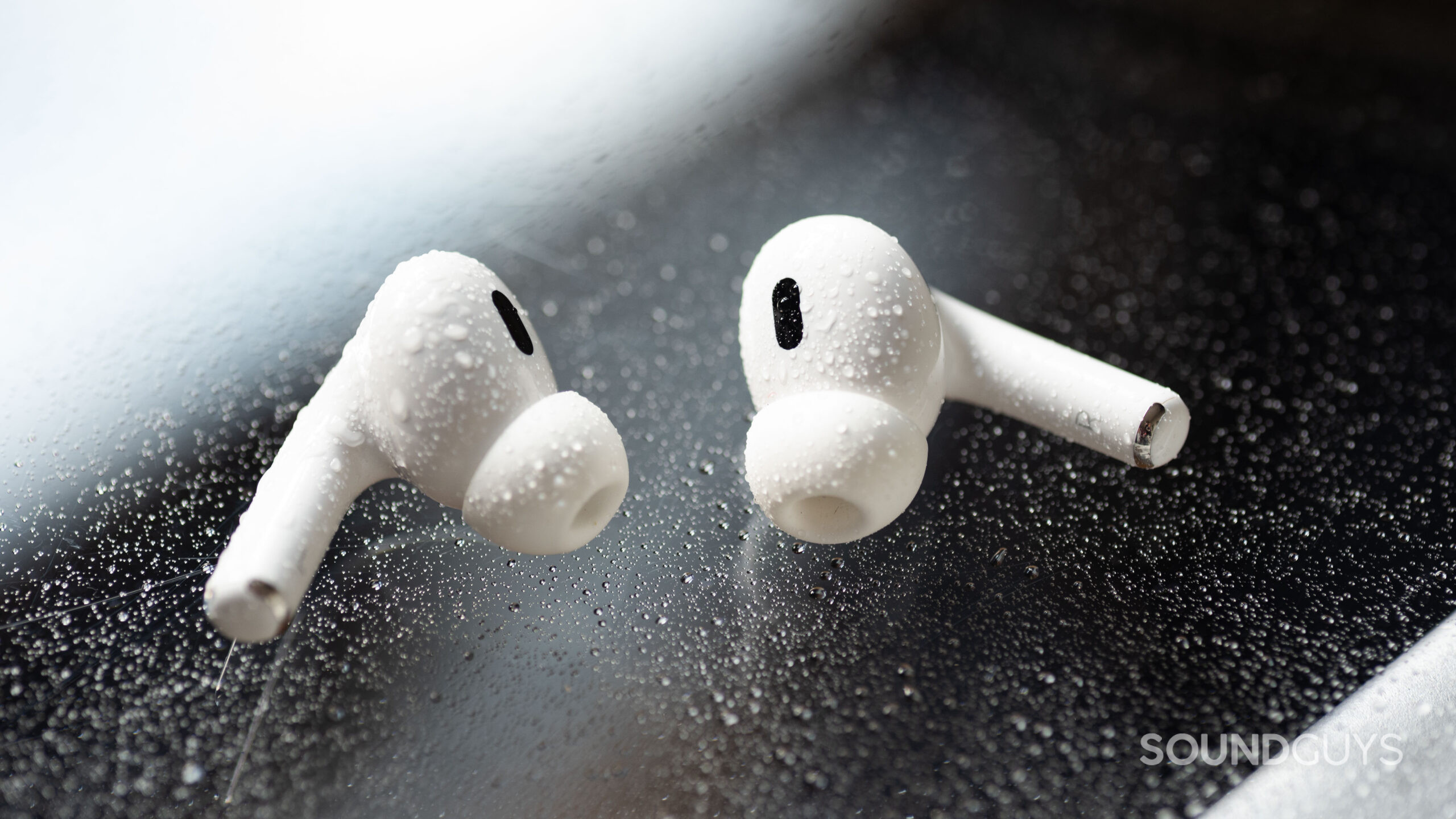
Though the Bose QuietComfort Ultra Earbuds carries an IPX4 ingress protection rating, the latest update to the Apple AirPods Pro 2 granted it an IP54 rating. The difference really only boils down to the fact that the Apple earbuds can resist dust, and the Bose earbuds weren’t rated for it, so if you were hoping that one product would be easier to work out with than the other, they’re both about the same.
However, there is a rather radical difference in designs. The Apple AirPods Pro 2 seals only to your ear canal, opting to forgo any backup, while the Bose QuietComfort Ultra Earbuds uses a concha fin to hold the earbud in place using your outer ear as well. Though the former design can be a little more comfortable, it ‘s a lot riskier, as a busted seal can mean the earbuds are more likely to fall out of your head. The Apple AirPods Pro 2 doesn’t have this difficulty, though a bad fit is a bad fit — sometimes your own head is the variable. As both earbud models have ovoid nozzles, we’re less concerned about a bad fit because the products are better-shaped for an actual human.
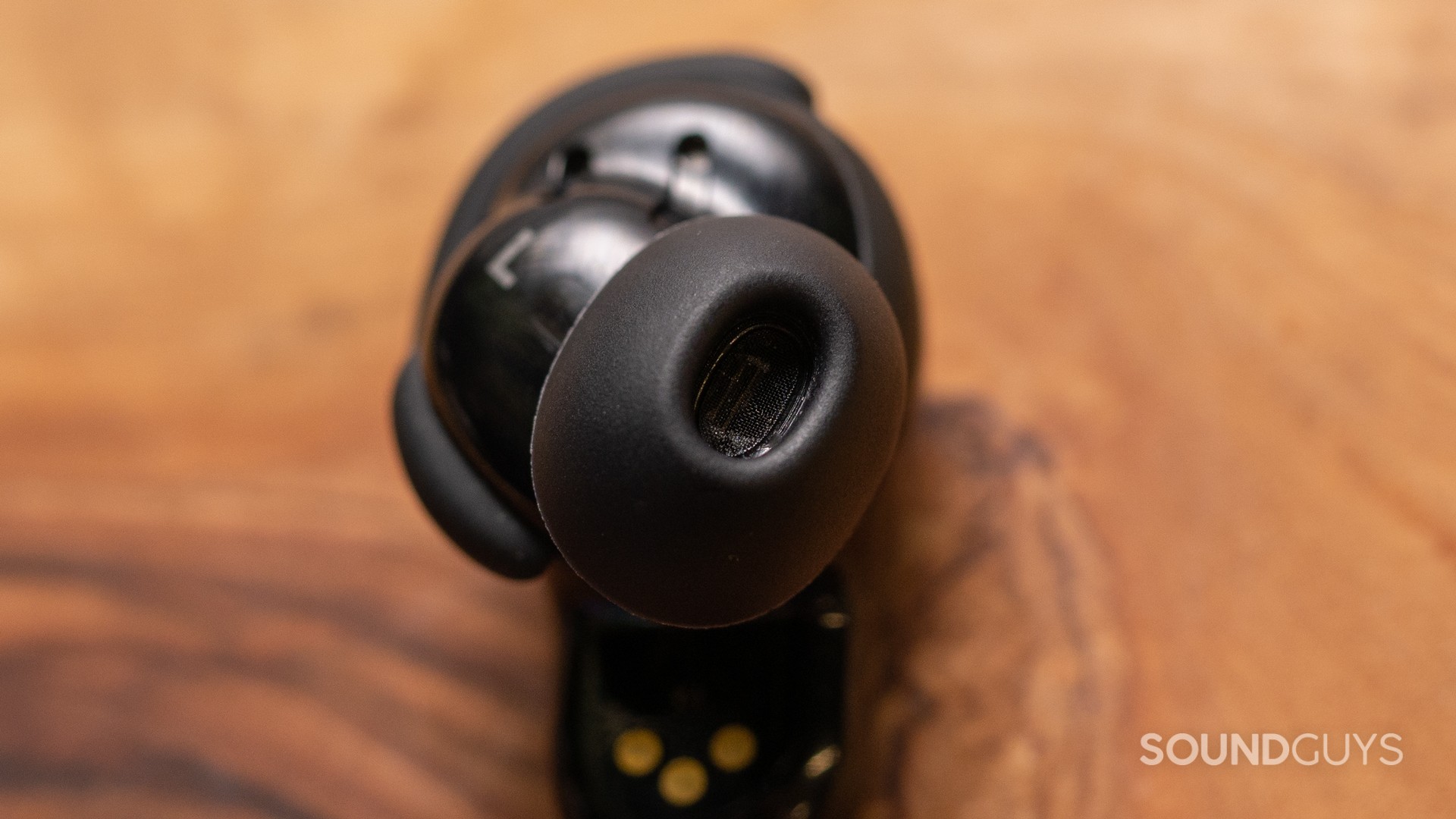
If you find that either earbuds are a less-than-ideal fit for you, then you may want to look for aftermarket ear tips. Though they’re not going to solve all of your problems, aftermarket tips can help earbuds fit slightly better when the manufacturer only includes those flimsy silicone ones in the packaging, like Bose and Apple both do.
How do you control the Bose QuietComfort Ultra Earbuds and Apple AirPods Pro 2?
Both products use touch controls, but the Bose QuietComfort Ultra Earbuds use a capacitive touchpad on the backs of the earbuds, and the Apple AirPods Pro 2 uses force-sensitive areas on the lollipop stem. We have a brief rundown below of how you can control each product.
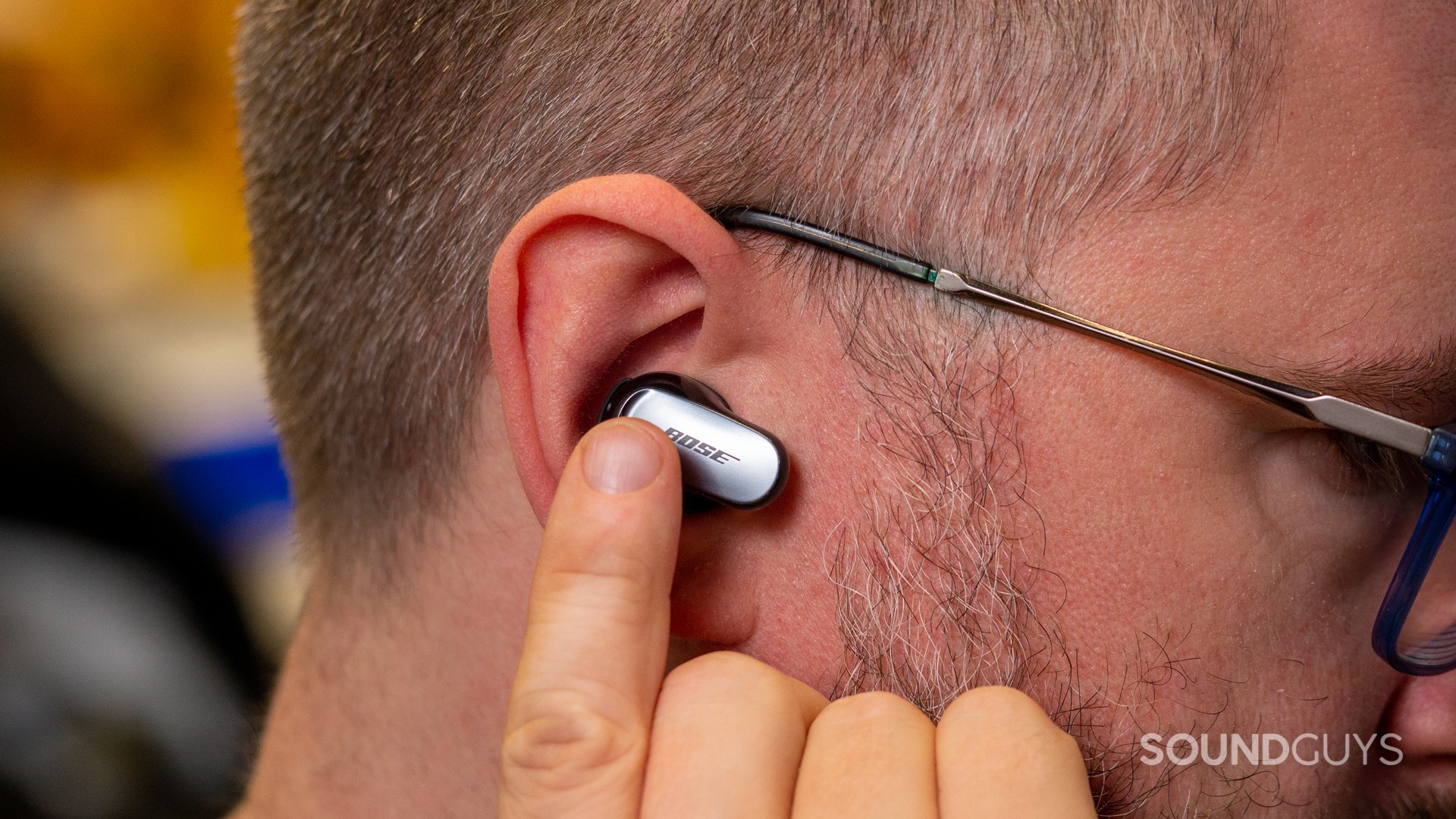
There’s no real advantage to either method, but it’s a matter of preference: would you rather squeeze a stem outside your ear, or would you rather tap and swipe your earbud? Just be aware that you can also perform most of the same controls through your smartphone if touching your ears doesn’t appeal to you.
Bose QuietComfort Ultra Earbuds controls:
| Gesture | Playback function | Call function |
|---|---|---|
| Gesture Swipe up | Playback function Volume Up | Call function N/A |
| Gesture Swipe down | Playback function Volume Down | Call function N/A |
| Gesture Tap | Playback function Play / Pause | Call function Answer call / Answer second call |
| Gesture Double tap | Playback function Track Forward | Call function End / Reject call |
| Gesture Triple tap | Playback function Track backward | Call function N/A |
| Gesture Long tap | Playback function Mobile device control / User control preset | Call function N/A |
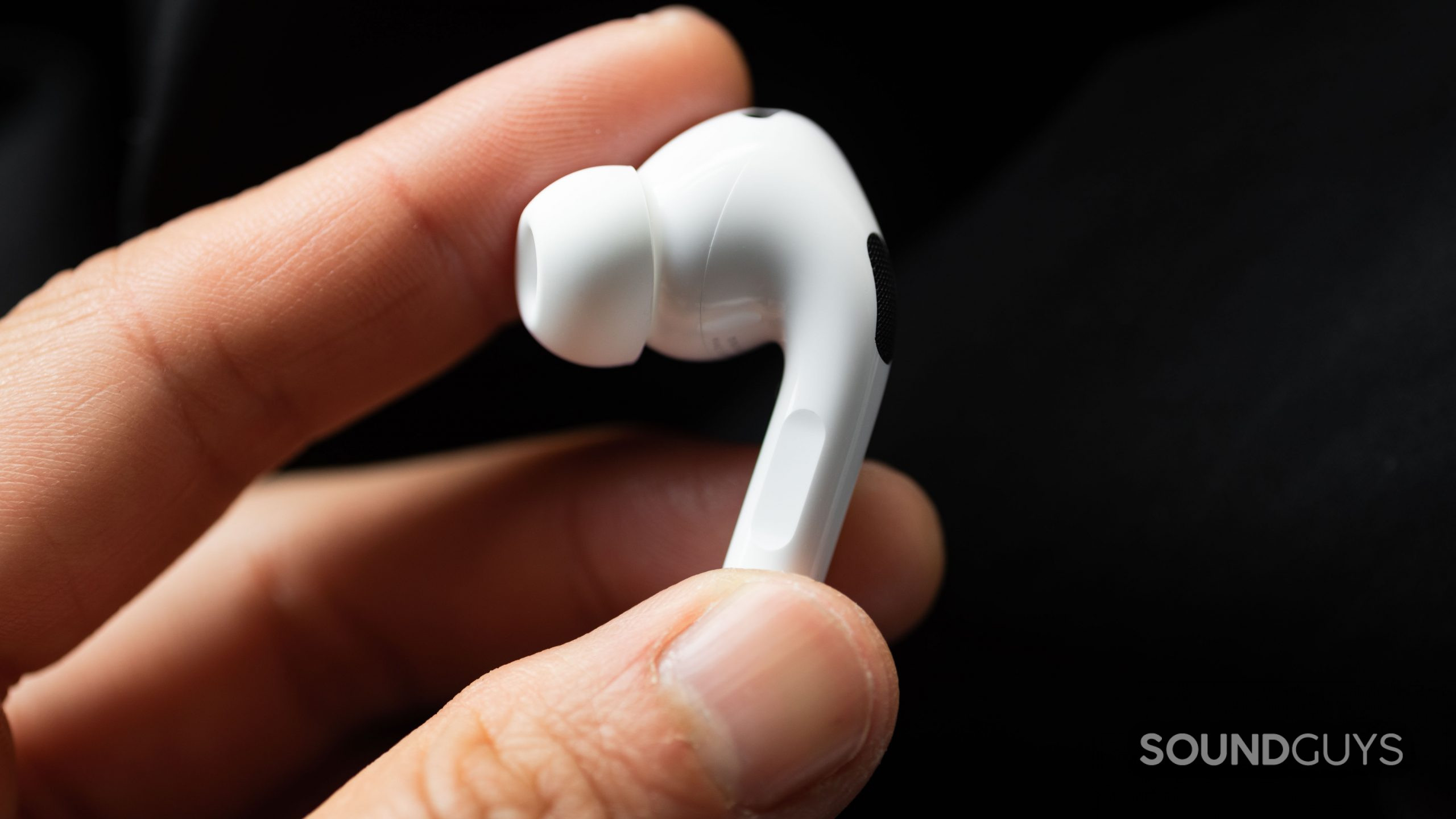
Apple AirPods Pro 2 controls:
| INPUT (stems) | ACTION |
|---|---|
One press | Play/pause/answer call |
Two presses | Next track |
Three presses | Previous track |
Press and hold | Toggle ANC/Adaptive Transparency modes |
Swipe up/down | Increase/decrease volume |
"Hey Siri" | Change volume, request directions, playback control, receive messages, and more |
Should you use the apps of either Bose QuietComfort Ultra Earbuds or Apple AirPods Pro 2?
With the Apple AirPods Pro 2, there really isn’t any worry about apps because the product was made for the Apple ecosystem — and therefore they’re specifically meant to be used with iOS. This does mean that if you have an Android phone, you’ll be missing out on a ton of the software features that make AirPods compelling for so many. For example, Spatial Audio and the benefits of the platform-locked chipset. You can also now use the AirPods Pro 2 as a hearing aid.
The Bose QuietComfort Ultra Earbuds on the other hand, rely on a first-party app for Android and iOS. The Bose Music app unlocks the advanced features of the Bose QuietComfort Ultra Earbuds, such as the in-app EQ, immersive audio, and firmware updates. Given that the features aren’t all that amazing yet, it’s not really a huge concern. However, if you don’t care to install the app: you can use the Bose Updater tool on the Bose website to keep on top of the latest software. In general, we like to point out that using a dedicated app for headphones will mean sharing some information with the publisher, so if you’re not comfortable with that, you can skip the app. We didn’t find the immersive audio feature compelling, so it’s not a huge loss to miss it.
How do the Bose QuietComfort Ultra Earbuds and Apple AirPods Pro 2 connect?
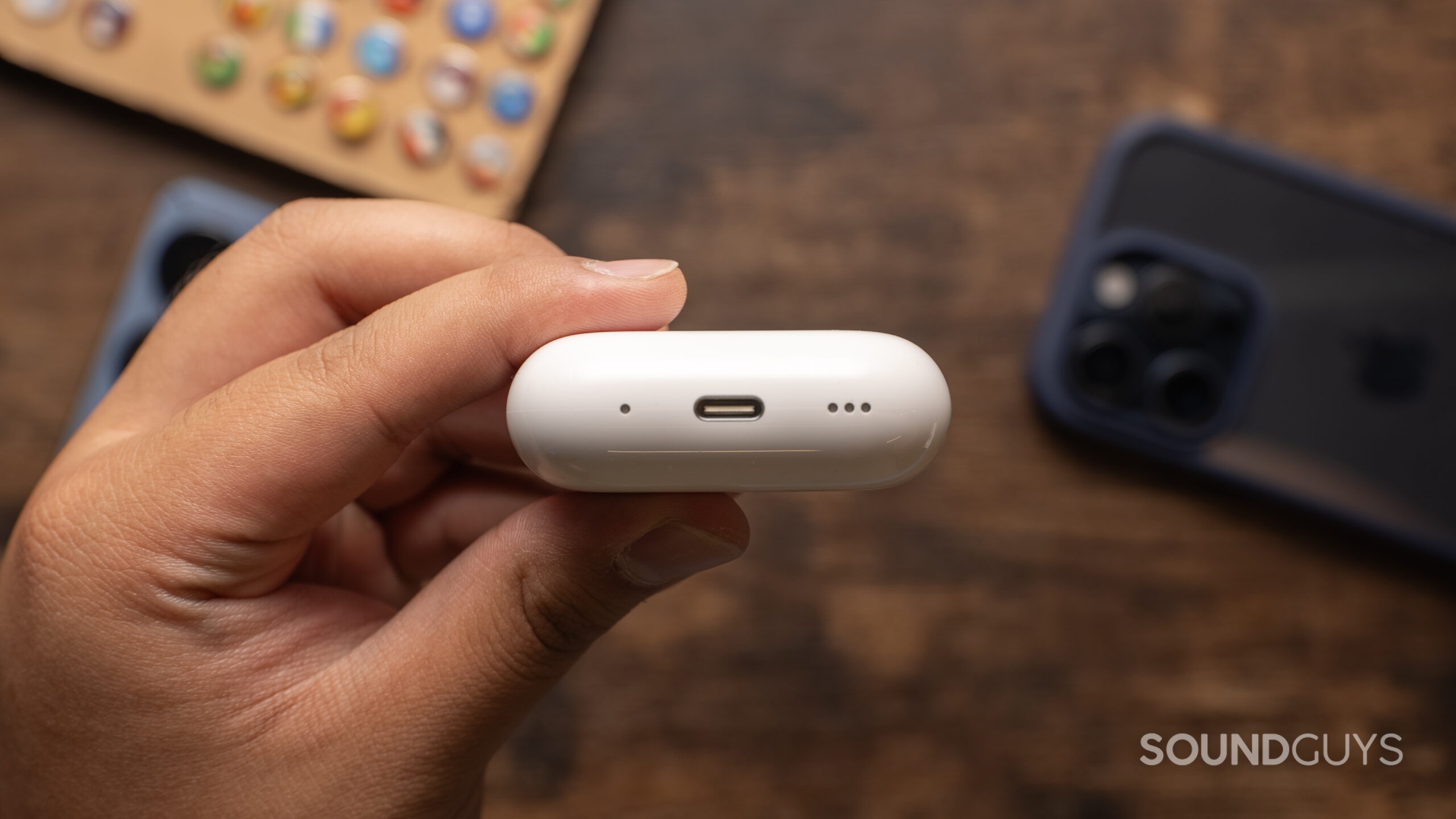
This is where the Bose QuietComfort Ultra Earbuds and Apple AirPods Pro 2 diverge more significantly. Where the Apple AirPods Pro 2 will connect to your source devices over Bluetooth via SBC or AAC, the Bose QuietComfort Ultra Earbuds can also make use of Qualcomm’s Snapdragon Sound to unlock the aptX Adaptive family of wireless codecs. This means that not only will you be able to make use of the higher bitrates they allow, but also you can enjoy lower latency on Android than you might with another codec.
Like the Apple AirPods Pro 2’s use of its native platform to make the most of its software features, the Bose QuietComfort Ultra Earbuds can only use Snapdragon Sound if you have an Android device with a Snapdragon 8 Gen. 2 or newer. Unfortunately, the Bose QuietComfort Ultra Earbuds will not be able to make use of the XPAN tech available with the latest chipsets released by Qualcomm, as it uses the previous generation.
Is battery life better on the Bose QuietComfort Ultra Earbuds or Apple AirPods Pro 2?
In our standardized test protocol, the Bose QuietComfort Ultra Earbuds was able to last 6 hours and 11 minutes, while the Apple AirPods Pro 2 was able to hold on for 5 hours and 43 minutes. Of course, you will be very unlikely to have listening sessions that long in one sitting, and you’ll also be storing these earbuds in their respective charging cases — so they’ll be recharging any time you’re not using them. Though nominally it may seem that the Bose QuietComfort Ultra Earbuds will be better over the long haul, that may not actually be true.
These products have tiny cells, and the Apple AirPods Pro 2 does have a few software features that prevent poor battery hygiene. While the overall longevity of the Apple products may be slightly longer than that of the Bose QuietComfort Ultra Earbuds, it’s not a guarantee — and heavily depends on your usage.
Do the Bose QuietComfort Ultra Earbuds or Apple AirPods Pro 2 block noise better?
Loading chart ...
The good news here is that both the Bose QuietComfort Ultra Earbuds and Apple AirPods Pro 2 are excellent when it comes to active noise cancelation. You really can’t go wrong with either — and picking a winner here isn’t really fair. Both are very effective at disrupting low-end noise, and both use non-cylindrical nozzles to meet your ear canal’s shape more effectively. This not only isolates you better from outside noise, but allows the earbuds to do their job more effectively.
Loading chart ...
The Apple AirPods Pro 2 may appear “better” on the chart, but the difference is more and more minor the higher on the chart you go. So, while there is that dip in effectiveness of the Bose QuietComfort Ultra Earbuds near the center of the chart, it’s not as noticeable as it might seem.
Do the Bose QuietComfort Ultra Earbuds sound better than the Apple AirPods Pro 2?
Comparing the sound quality of these two products has a slew of caveats attached, as one is more suited for mass appeal, while the other has more means to satisfy the really picky people out there in a very specific way. From a frequency response standpoint, the Apple AirPods Pro 2 will probably satisfy more people than the Bose QuietComfort Ultra Earbuds, as it doesn’t over-emphasize bass, and it doesn’t have a strange overemphasis in the highs. Of course, you can use the app to help out the Bose QuietComfort Ultra Earbuds a bit, but because it’s so limited, there’s only so much you can nudge the sound to your liking.
Loading chart ...
Of course, the Apple AirPods Pro 2 can’t keep up with the bitrate that the Bose QuietComfort Ultra Earbuds offers when connected with an Android phone. In that respect, the Bose QuietComfort Ultra Earbuds comes out on top. However, if you have an iPhone, both earbuds will have roughly the same bandwidth limits, as the iPhone only uses SBC and AAC.
Where the difference is most stark is the spatial audio. Where the Apple AirPods Pro 2 have the best implementation of the feature we’ve seen so far, the Bose QuietComfort Ultra Earbuds try to emulate a speaker in front of you — and the original stereo mix is pretty much always better to listen to. It’s fine, but it isn’t quite the same thing.
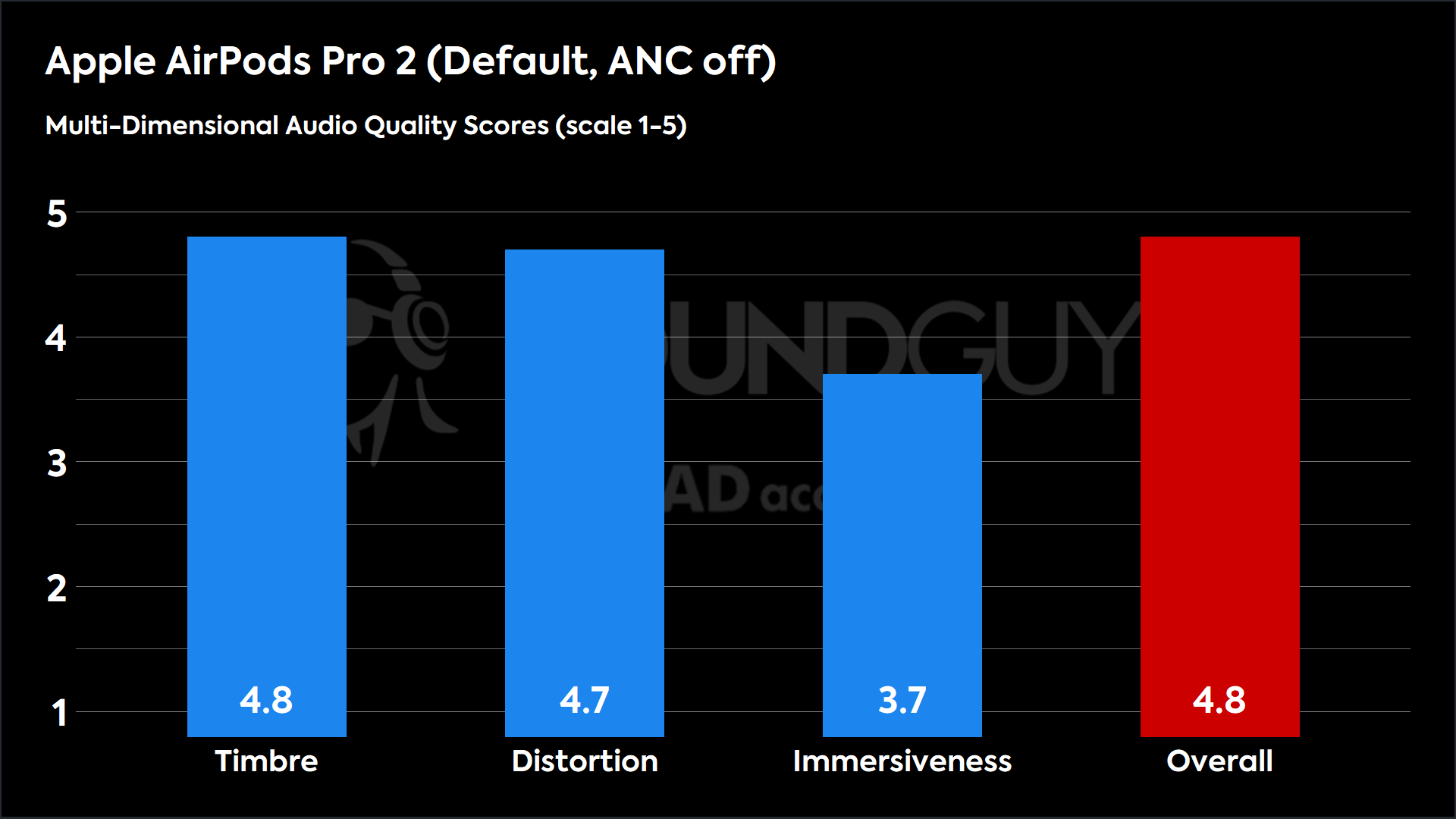
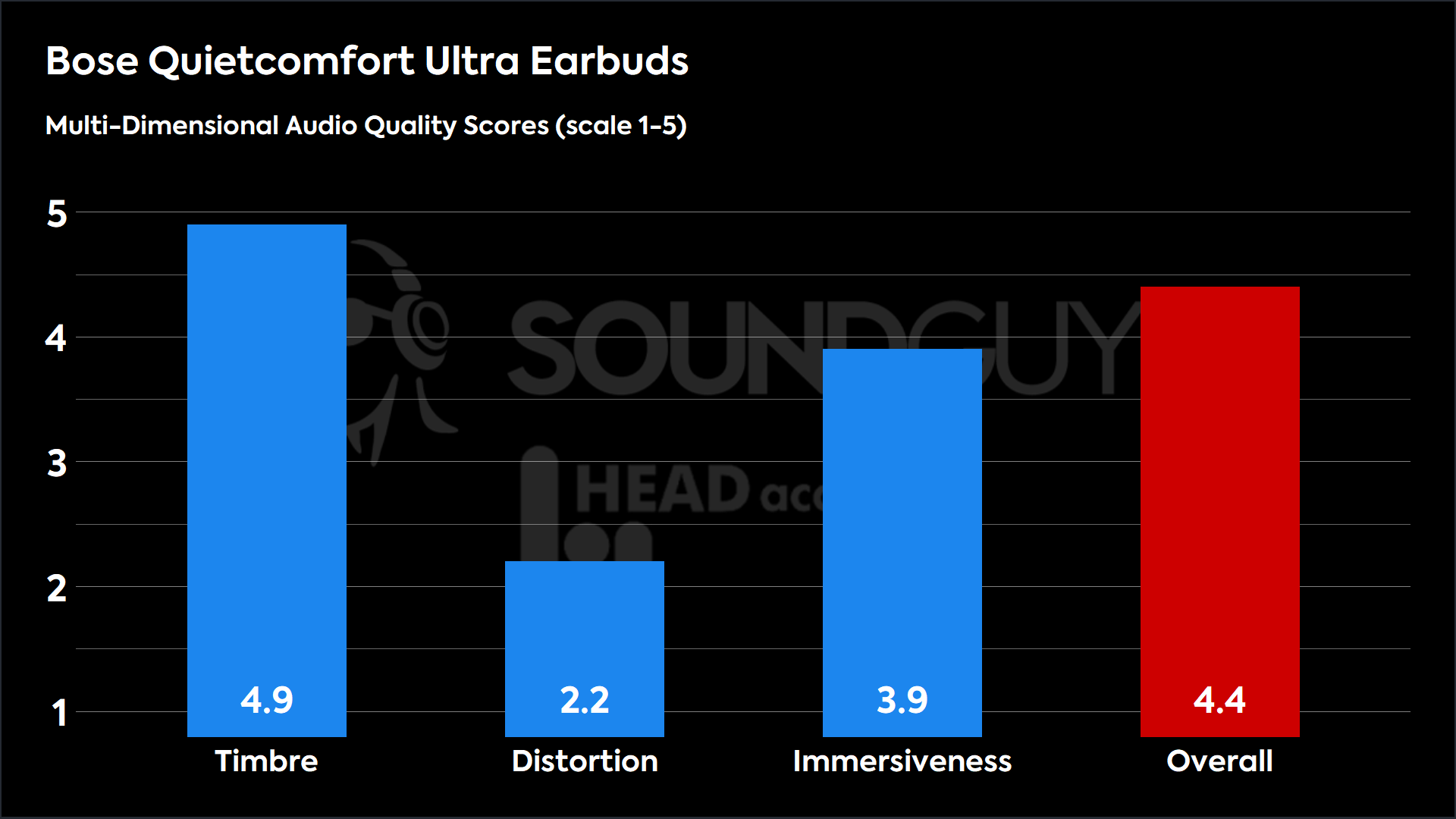
The AirPods Pro 2 score higher than the Bose QuietComfort Ultra Earbuds according to MDAQS testing. That said, both attain high overall scores on a scale from 1-5. This means there is a high chance most people will enjoy the sound quality of both the AirPods Pro 2 and Bose QuietComfort Ultra Earbuds.
Do the Bose QuietComfort Ultra Earbuds or Apple AirPods Pro 2 have a better microphone?
When we compare microphones, we prefer to let you be the judge. That way, there aren’t any nasty surprises waiting for you when you decide to buy one or the other. The samples below were recorded in our testing lab under the same conditions, to compare the performance of each more effectively.
Bose QuietComfort Ultra Earbuds microphone demo (Ideal conditions):
Apple AirPods Pro 2 microphone demo (Ideal conditions):
Bose QuietComfort Ultra Earbuds microphone demo (Windy conditions):
Apple AirPods Pro 2 microphone demo (Windy conditions):
Which microphone sounds best to you?
We chose to highlight the windy conditions here as this is the kind of noise you’ll run into on a call outside. We did notice that the Apple AirPods Pro 2 has a harder time maintaining your voice in wind, though it’s much more aggressive in suppressing the noise it causes. Just keep in mind that the quality you hear above may not be the quality your conversation mates will hear, as networks are often the sound quality bottleneck and not the little microphones in your earbuds.
Bose QuietComfort Ultra Earbuds vs Apple AirPods Pro 2: Price and availability
Though both products should be found just about anywhere that sells headphones and earbuds, the Apple AirPods Pro 2 come in at about $50 cheaper than the Bose QuietComfort Ultra Earbuds at full price. Additionally, since it’s a little bit older than the Bose earbuds, the AirPods Pro 2 will most likely be on sale every now and again, driving that gap ever wider.
Of course, there’s then the complication of exactly what are you getting when you find the Apple AirPods Pro 2 on sale? Ever since Apple’s switch from Lightning to USB-C, you might find a lot of frustrated vendors attempting to recoup some value on the older stock, leading to an unwelcome surprise when your order ships. In order to avoid this, try to stick to reputable vendors and big box stores, as they are generally much better about labeling which earbuds are on their product pages, and most have a good return policy if you get the wrong thing.
Should you get the Bose QuietComfort Ultra Earbuds or Apple AirPods Pro 2?
As much as it may seem obvious at this point, the Bose QuietComfort Ultra Earbuds is best for Android users with a recent phone, and the Apple AirPods Pro 2 is better for iOS users. It’s frustrating that you can’t get the latest or most compelling features of the Apple AirPods Pro 2 without an iPhone, but if you have one: it’s hard to beat for the money. Likewise, the best improvements of the Bose QuietComfort Ultra Earbuds are not available to users without an Android phone with anything other than a Snapdragon 888 processor or newer.
If you don’t fall into either of these camps, both earphones will lose some features, and also some of their compelling points to choose one over the other. These are both great earbuds in their own right, and what you need depends almost entirely on what you’re going to be using these earbuds with.

Immersive audio
Customizable fit

Comfortable fit
Wireless charging
Should you get the Bose QuietComfort Earbuds (2024) instead?
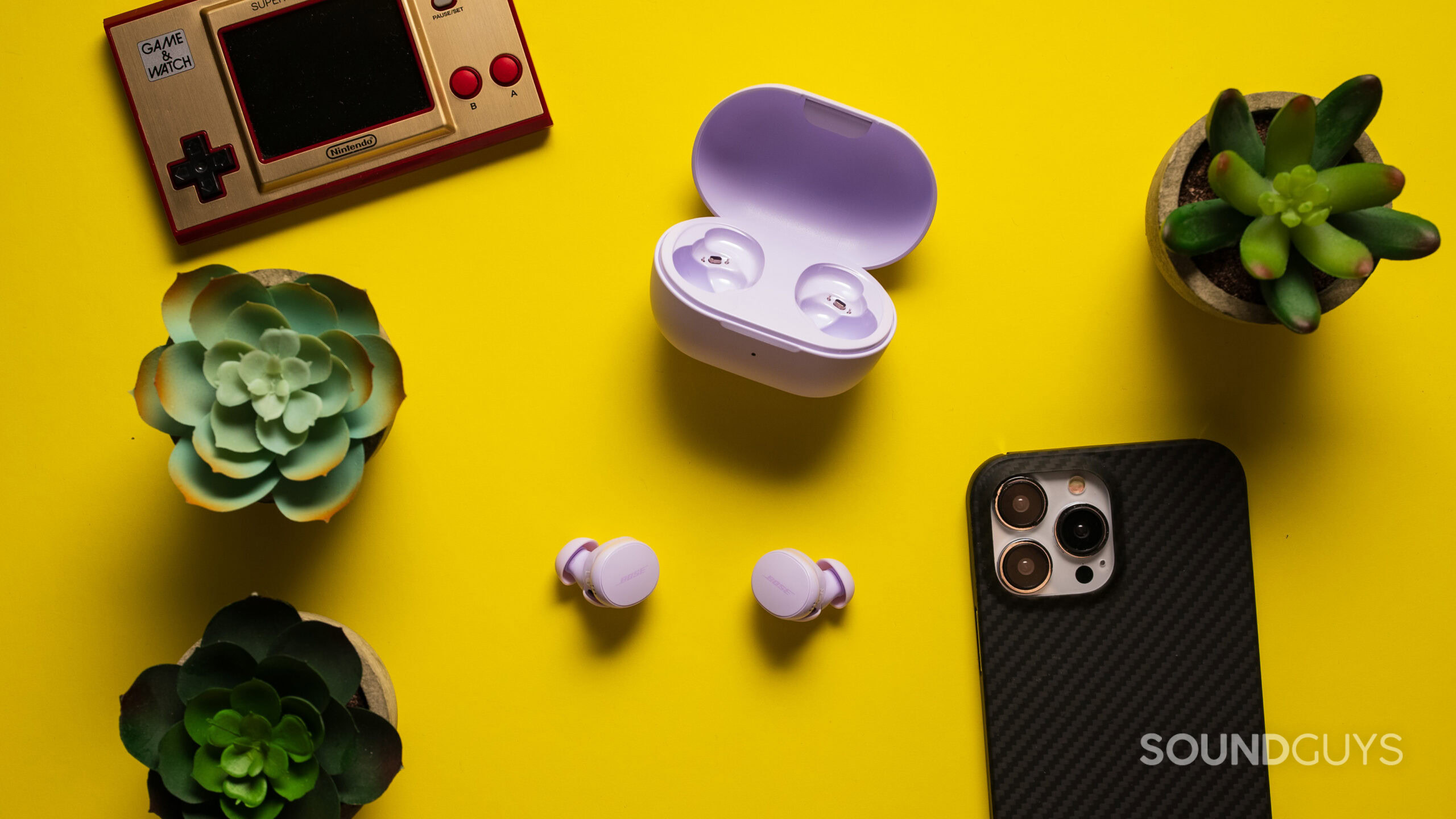
The new Bose QuietComfort Earbuds (2024) are a better value buy than the Bose QuietComfort Ultra Earbuds. In our Bose QuietComfort Earbuds (2024) vs Bose QuietComfort Ultra Earbuds comparison, we found that most people should save their money and get the cheaper QuietComfort Earbuds instead of the Ultra model. The mediocre immersive audio features aren’t worth the big increase in price to get the Bose QuietComfort Ultra Earbuds.
On the other hand, in our Bose QuietComfort Earbuds (2024) vs Apple AirPods Pro 2 comparison, we found that the AirPods Pro 2 are worth the money for Apple device owners. The seamless connectivity and plethora of features within the Apple ecosystem are unmatched.
Frequently asked questions
Both sets of earbuds can only protect against indirect moisture. They are not waterproof.
Yes, but the higher-bitrate codecs and Snapdragon Sound are not available on any phone without a Snapdragon 888 or newer.
Yes, but they lose all the software features baked into iOS, such as Spatial Audio.
Only the Apple AirPods Pro 2 offer wireless charging in a special case.
Please don’t, it’s not good for your ears.